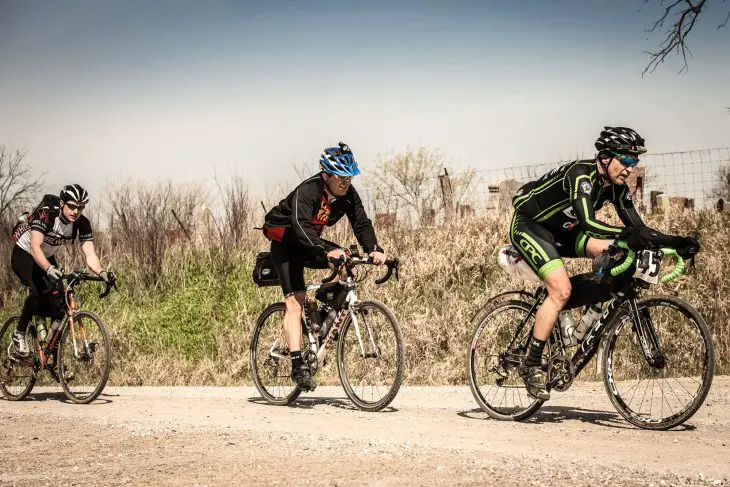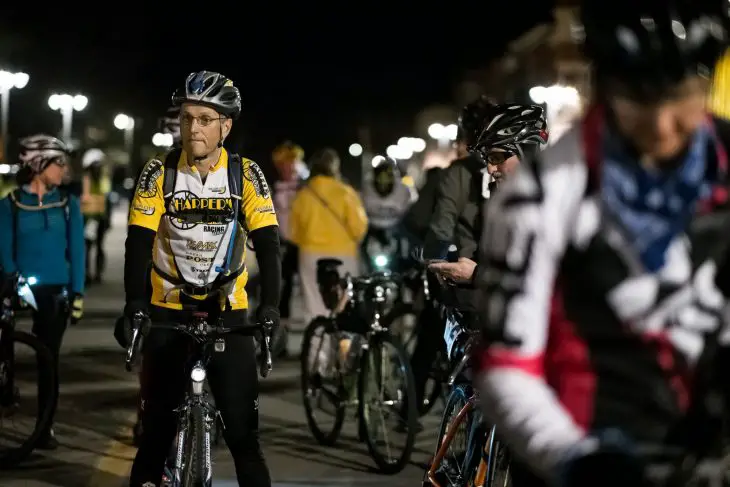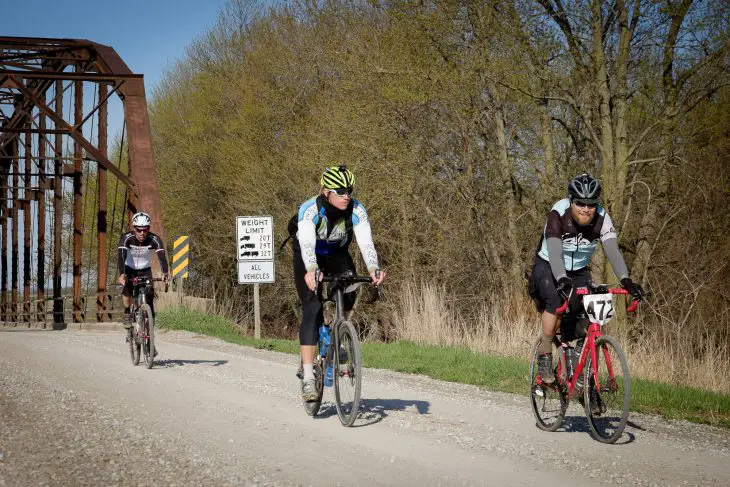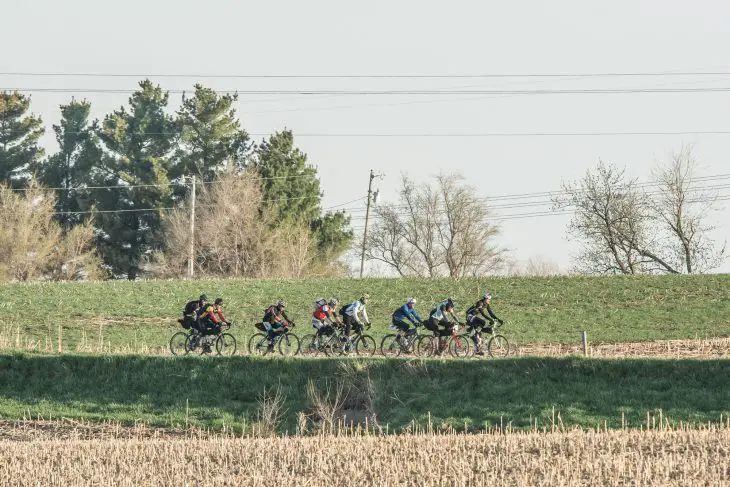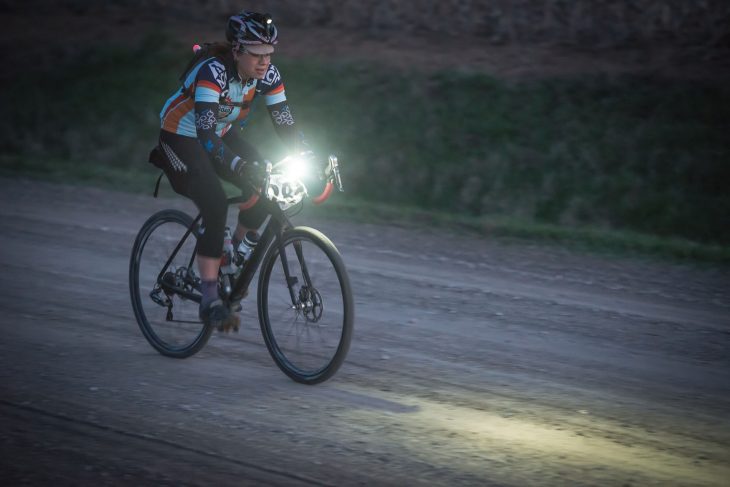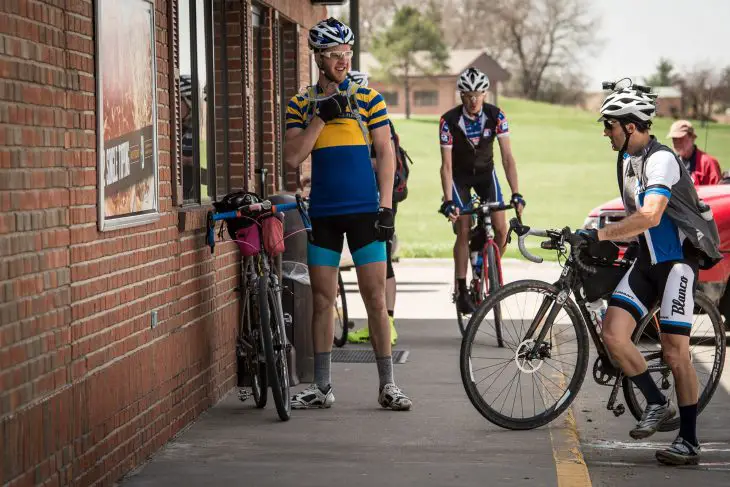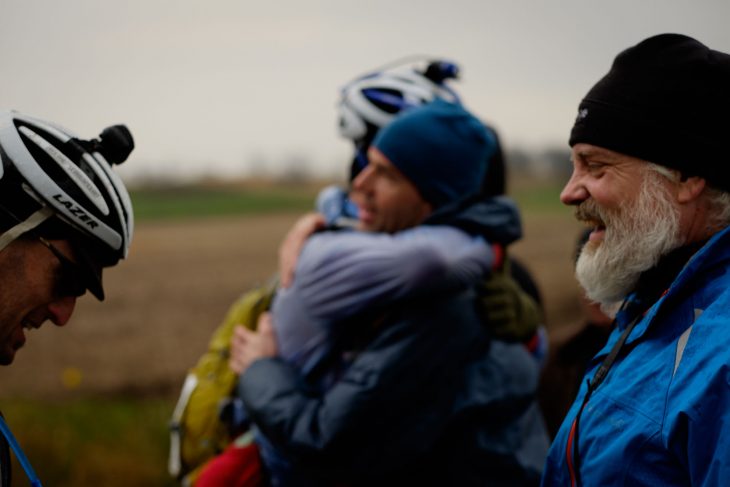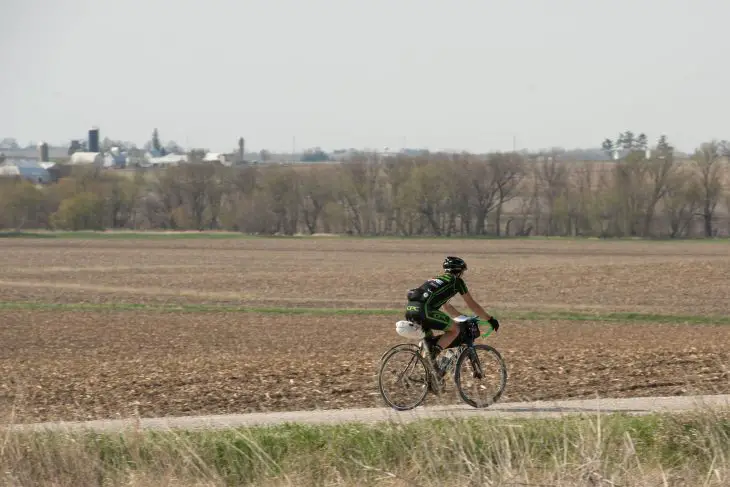Deeds done and lessons learned: Gravel racing in the american midwest.
Words by Mark Elsasser. Photos by Wally Kilburg.
First published in Grit.cx Issue 1: October 2014
Mike Tyson once said: “Everyone has a plan until you get punched in the face.” Trans Iowa is the heavyweight fighter that stalks the rolling hills of rural Iowa, ready to lay out anyone who steps into the ring. Months of planning and preparation often end in a knockout punch, with racers lying in a muddy ditch on the side of a gravel road wondering what hit them. Much like a prizefighter facing a bigger, stronger, faster opponent, it’s a test of mental and physical limits beyond what most ordinary people can imagine.
Trans Iowa is a 300+ mile, self-supported, self-navigated gravel road race held on the last weekend of April in Grinnell, Iowa. The length of the race, which varies slightly from year to year, approximates the distance it takes to traverse the state of Iowa between its borders with Nebraska and Illinois at any given point. Originally conceived as a point-to-point race, the course format was changed to a ‘big assed loop’ for the third edition of the race to make logistics easier for both organisers and competitors. There is a 34-hour time limit to finish, which roughly translates to a 10 mile per hour pace for the entire distance, including stops.
When entering Trans Iowa, competitors agree to a simple set of rules, the most important being the Trans Iowa Golden Rule: YOU ARE RESPONSIBLE FOR YOU. The self-sufficient nature of the event is what distinguishes Trans Iowa from many other ultra-endurance events, and provides racers a unique opportunity to push themselves to their limit and beyond.
Take one.
I committed to Trans Iowa v10 the moment I abandoned the previous year’s edition in some dusty corner of northeastern Iowa. It was my first attempt at self-supported ultra-endurance racing, and I had underestimated the challenge. Trans Iowa rookies truly don’t know what to expect until they roll out of Grinnell for the first time in the darkness of night. Then it quickly becomes apparent that Trans Iowa is no ordinary bike race. Failing to finish on an initial attempt is common, and for many, the knowledge gained from the experience strengthens one’s resolve to face the challenge again.
Perhaps the most important lesson I learned from my initial attempt at Trans Iowa was choosing the right tools for the job. In preparing for the 2013 race, I had focused on training rather than optimal equipment set-up. I had experienced good success in 24-hour solo mountain bike racing a decade earlier, and I had had a solid finish at the previous year’s Dirty Kanza 200, a gravel road race held in the Flint Hills of central Kansas. Given those experiences, it only made sense to apply what had been a winning formula to Trans Iowa.
Consequently, I showed up at the starting line of the 2013 race having made some decisions I’d later regret. I had set up my single speed cyclocross bike with traditional randonneuring bags, which was not the best choice given the difficulty of the terrain and the elements. I also had twice as much gear as most of my competitors. Navigating a heavy bike, with poorly distributed weight, over endless hills and loose-over-hardpacked gravel roads was more of a challenge than I had anticipated. The Iowa gravel roads are altogether different from the smooth, lightly-traveled gravel roads of the verdant Flint Hills of Kansas. And as one of a handful of singlespeeders in the race, it was difficult to keep pace with small groups of racers who had the option of shifting gears to adjust to the constantly changing course conditions. My rear wheel skittered laterally over loose gravel every time I got out of the saddle, and I often found myself riding alone, wrestling to keep my bike upright as I was buffeted by horrible crosswinds.
At the 182-mile mark, I decided I’d had enough.
Reflecting on the experience, I had the confidence I could finish with the same fitness level, different equipment choices and a better race strategy. A week later, I competed in the 135-mile Rapha Gentleman’s Race on a geared bike, my first race with shifters in over a decade. Shortly after, I made the decision to show up at next year’s Trans Iowa with the best tool for the job. A geared bike seemed to be the logical choice given my experiences at both events. It would be a huge adjustment after years and years of exclusively racing singlespeeds, but in the end, endurance racing is all about adapting.
Second guess.
An unusually harsh winter in the northeastern US posed a serious concern for my training plan. Four months of rain, snow and freezing temperatures delivered a significant challenge, but I battled the elements and banked plenty of saddle time. Jack Frost wasn’t going to get in the way of making it to the finish line in Grinnell. A 167-mile training ride in the cold and rain one month before the race gave me the confidence I could push through any conditions, and I estimated I had enough miles in my legs to get the job done.
Three days before the 2014 edition of the race, I made the journey from Philadelphia to Des Moines with great fitness, a geared bike, lighter and more aerodynamic gear bags, a better race strategy, and a renewed sense of optimism that I could make it to the finish.
When I finally arrived at the host hotel in Grinnell the afternoon before the race, the nervous energy that had consumed me in the run up to the race was all but gone. I was ready to give Trans Iowa my best shot. But my pre-race anxiety resurfaced as I began the process of loading up my bike with gear. Decisions about gear and supplies can make or break you at Trans Iowa, and the last minute choices I faced put me on edge. I surveyed the gear laid out on the floor and muttered a few choice words.
I shook down my gear, and shook it down again. I cursed, and cursed again. I began to second-guess myself: ‘Do I have too much stuff, or not enough?’ ‘Have I planned for every scenario?’ Many Trans Iowa racers go through this same routine, and it sometimes results in bad decisions. Other times it results in the winning combination. The less-than-favourable conditions in the weather forecast for this year’s race made equipment decisions that much harder. I began to split the middle with some equipment choices: full rain gear stayed in the pack; a flask of bourbon stayed on the hotel room floor. This went on and on and on until I decided I was done with race preparations once and for all. It was time to get on my bike and go.
The weather was the talk of the mandatory racer meeting the night before the start. Rain was forecast for Saturday night into Sunday, which had the potential to end everyone’s race early. Still, there was plenty of optimism among racers. The weather is always the wild card at Trans Iowa, and it’s beyond everyone’s control. Fortunately the camaraderie among Trans Iowa racers helps everyone to face the looming challenge. Trans Iowa is more about external factors and challenging your own limits than it is about the competition.
Take two.
Race morning began with a 2:00am wake-up call. Unlike many nights before a big race, I slept well and awoke feeling rested and positive about the challenge ahead. The host hotel was kind enough to change the starting time of its complimentary breakfast, and by 2:30am, the dining room was packed with nervous energy. Racers knocked back cups of weak coffee and packed in last-minute calories from the breakfast buffet as their support crews tended to last-minute details. The parking lot in front of the hotel was a hub of activity, with racers gathering for the short ride to the centre of town where the race was scheduled to start at 4:00am.
To save as much energy and battery power as possible, many racers soft-pedaled down the highway to the starting line. By 3:30am, the street in front of the bike shop just off the main street of Grinnell was filled with racers, their support crews and event volunteers. Just before the start, Guitar Ted gave a few last minute instructions, and with that, 105 intrepid adventurers rolled out of the Grinnell town center under a neutral start. The peloton stayed together until a right turn onto a gravel road just outside of town. The flag dropped, and the front of the pack accelerated. The race was on.
Black skies and a waxing moon provided the backdrop for the opening miles of the race. A long line of lights extended in front of me as we left town and headed to the countryside. The front of the race seemed to be going full-throttle, but I wasn’t eager to mix it up that early in the race. That opportunity would come later if my legs were good. As the course turned onto the first ‘B’ maintenance road, I was in my element. I weaved in and out of racers bogged down in the muddier sections of the road, finding the best lines and passing a good portion of the field.
I turned off the ‘B’ road feeling optimistic about my chances. The nervousness of the opening miles faded, and the miles ticked off easy as the sky transitioned from black to purple to orange to blue. I contemplated the freedom of pedaling through the farmland of rural America as the sun rose in the sky. The race seemed secondary to the experience. Moments like these keep me coming back to bike racing. I soaked it all in, knowing there would be more difficult miles ahead.
Six-packs and sympathy.
I rolled into checkpoint one in Lynnville at mile 54, averaging close to 14 miles per hour. Quick stops at the C-store and the control point, and I was on my way. Leaving Lynnville, the course turned east and into the wind. The easy, freewheeling pace of the first 50 miles was no more. I labored heavily as I pushed through non-stop hills and straight into the steady 20 mile per hour headwind. My pace began to drop off precipitously. I tried my best to stay on the wheels of the racers who were catching me, to no avail. My legs would not respond to the slightest of accelerations. I knew I was in trouble.
By the 100-mile mark, I was averaging just over 10 miles per hour, barely fast enough to make the time cut for checkpoint two. I did the math, considered the gloom-and-doom weather forecast for the overnight hours, and concluded my race was over. I thought back to my 24-hour racing days and remembered one of my favourite sayings: “You gotta know when to hold ‘em, you gotta know when to fold ‘em.” I was fading fast and it was time to fold ‘em. I consulted the cue sheets, and calculated I’d arrive in civilization before too long.
My race ended at mile 113 in a sun-swept Casey’s C-store parking lot in North English, Iowa. Months of preparation felt like a waste of time and I wondered if this was the last time I’d un-pin a race number from my jersey, not just at Trans Iowa, but anywhere. Perhaps it was time for retirement. I called my wife to let her know I was done. She hadn’t expected a call that early in the race, but didn’t question my decision to abandon. She arrived in North English an hour later with a six-pack and sympathy. I cracked a beer and loaded my bike into the rental as the back of the race trickled into the parking lot.
I spent the drive back to Grinnell thinking out loud, verbalizing what I had been contemplating over the last six hours of pedaling. For the first time in 20 years of bike racing, I doubted my ability to finish a race. Not only had I cracked, I had shattered into a million pieces in the wind and hills. The fact I had pulled the plug before the conditions got really bad made it that much worse. The challenge of Trans Iowa seemed insurmountable. By the time we got back to Grinnell, I was uncertain I’d live to fight another day.
Later that night, my head hit the pillow with the sounds of the Iowa wind roaring in the background. The wind had not let up since I left North English, and I started to feel better about my decision to quit the race. I was woken periodically through the night, either by the electrical storms that had moved into the area or by the sounds of vehicles pulling into the parking lot just beneath my hotel room window. There was a routine that seemed to repeat itself throughout the night: the sound of a car engine turning off; the opening of a vehicle door; the voice of a reassuring support person trading a few words with a soul crushed by the wind, rain and the undulating hills of America’s heartland. The anonymous voices provided more validation I had made the right call.
Just after sunrise, I drove to the finish line, an old barn on the edge of town within sight of the Interstate 80. The race winner, Greg Gleason, had finished minutes before, and a small group of volunteers, support crews and racers who had abandoned eagerly waited for the next finishers. A small campfire burned. Folks sat around drinking coffee and beer while swapping war stories. Those who had pushed past the second checkpoint had encountered some of the nastiest weather Trans Iowa had ever seen. The elements had taken a toll on the field and everyone seemed to have a story. The field had dwindled to 22 racers at that point, and the weather was still threatening.
I hung around the finish for a while chatting with friends and fellow racers. Matt Gersib, a former Trans Iowa finisher and veteran gravel racer, abandoned the race roughly 30 miles from the finish line. He battled the elements through the night and decided to call it quits when faced with riding a 10-mile stretch of wet gravel roads into a 40 mile per hour headwind. Other racers had stories of holing up in abandoned barns and houses to wait out severe thunderstorms that had swept across the eastern part of Iowa. Some racers were able to continue after the storms passed. Others weren’t.
The camaraderie at the finish was just what I needed. I was still feeling the disappointment of being 0 for 2 in Trans Iowa attempts, but hearing everyone’s stories reminded me of how difficult it is to merely finish the race. Sometimes, it’s just a matter of perspective. Matt shared, “Merely attempting Trans Iowa makes you a better person. There’s valor in facing the challenge even if you don’t finish.” But in the end, only the strongest survive at Trans Iowa. And even for the strongest, bad luck or a rash decision can translate to going home early. It’s just the nature of the event.
Inside the Trans Iowa.
Trans Iowa is the brainchild of Jeff Kerkove and Mark Stevenson (aka Guitar Ted) – two bike shop mechanics who dreamed up the challenge in 2004 while working at the Europa Ski and Bike shop in Cedar Falls, Iowa. While Jeff has moved on, Guitar Ted remains involved and is the heart and soul of the race. Anyone who has ever participated in Trans Iowa will tell you that his passion is what drives the event and makes it so special. Though racers commit to the Trans Iowa Golden Rule as a condition of participation, the rule applies only to what happens on the gravel roads of rural Iowa during the race itself. Guitar Ted tends to every other detail imaginable in order to provide racers with the best experience possible.
The Trans Iowa route changes from year to year. The course is painstakingly reconnoitered by Guitar Ted each fall, then revisited in the spring in the weeks prior to the race. Though racers may pick up bits and pieces of course beta from postings on Guitar Ted’s blog and other social media outlets, the route is kept secret until racers are provided with their initial set of cue sheets at the Pre-Race Meat Up at the Grinnell Steakhouse the night before the start. The first set of cue sheets brings racers to the first checkpoint, typically 50 to 100 miles from the start. Racers must reach this checkpoint within a designated time limit in order to receive the next set of cue sheets, which enables navigation to the second checkpoint. This scene repeats itself at the third checkpoint, where racers are provided with the information they need to navigate to the finish line in Grinnell.
The Trans Iowa course is almost entirely on gravel. Pavement is encountered sporadically, most often when the course crosses county and state roads or visits the occasional village or town. The towns along the route play a critical role in race strategy, as racers are expected to be self-sufficient. Most towns have convenience stores – ‘C-stores’ in race vernacular – and they are heavily relied upon for food, water and other supplies.
Contrary to popular belief, Iowa is not flat and its rolling hills are not to be underestimated. The variability of the gravel roads navigated during the race offer an additional dimension of difficulty. In Iowa, the endless gravel roads are maintained by county government, typically on their own schedule and largely dependent on the winter weather. A mild winter, such as the one in prior to the 2013 race, means there will be literally tons of fresh gravel on the Trans Iowa course, with road conditions varying as you cross county lines. Pedaling through freshly spread gravel is akin to riding through deep sand on the beach. Riding on ‘loose-over-hardpack’ gravel surface can give you the sensation of riding on top of ball bearings or marbles spread across the road. Vehicle tyre tracks on either type of surface may provide a smoother surface, but with a small margin of error. Rain can cause both the gravel and ‘B’ roads to be impassible, as was the case during the second and sixth running of the event.








